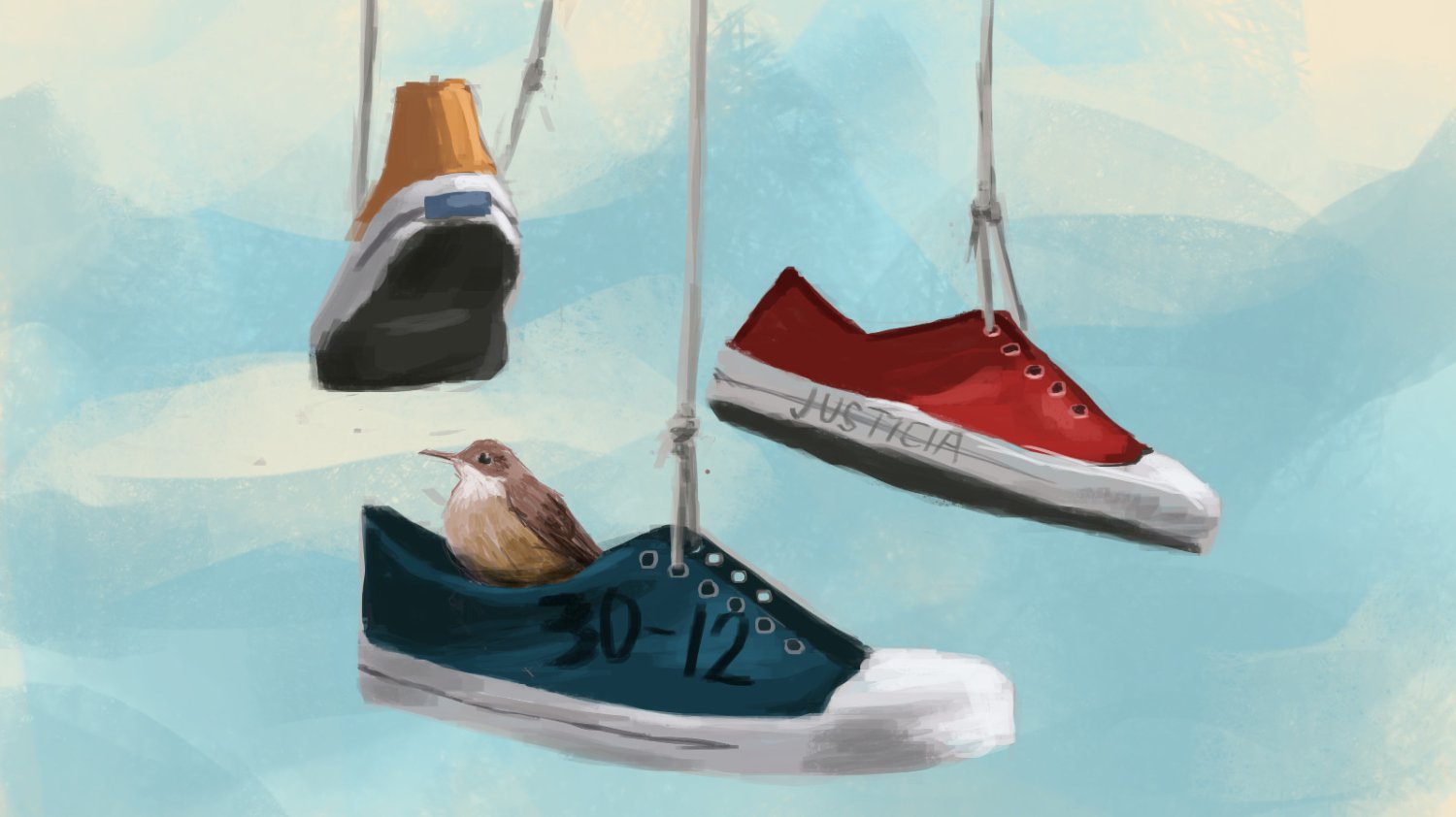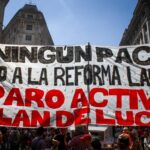
On December 30, 2004, a bowling alley in the Once neighborhood, Cro-Mañón Republic, caught fire. That night Callejeros played, and what promised to be a rock party turned into a massacre with 194 dead and more than 1,500 injured. 20 years of Cro-Magnon, 20 years of an announced massacre. Neither a flare nor Rock and Roll: our kids were killed by corruption. 20 years of political impunity, 20 years of struggle by survivors, relatives and a daily fight for memory.
After 11 at night the band began to play, as part of a series of recitals at the place. Callejeros sounded more and more and had become one of the rock bands, with rebellious lyrics, of the moment. A flare was thrown into the bowling alley. It was common to use them in recitals (today they are still used on the court). For the fans it was synonymous with celebration and joy in what should be a party. The flare lit a half shadow on the roof, the fire went up in smoke, the electricity was cut off, the fire extinguishers were empty as a result of a fire days before and the emergency exit was padlocked. The place was exploding with people: 1,000 people entered but there were 4,000.
A cave like the hundreds that existed for popular recitals and clubs, or “death chamber” as some survivors called it during the later trials. Each kid or girl got out as best they could and many did not make it. Many others returned to rescue those who could, removing them as they could, while the smoke invaded every corner of the premises. Subsequent investigations, which were part of the criminal case, determined that most of the deaths occurred due to the inhalation of carbon monoxide and hydrogen cyanide. And the fatalities could have been more if it had not been for the fact that many of the spectators who managed to leave re-entered to rescue people who were still inside the establishment.
The fight for justice was in the streets
After the crying and pain, the search for hospitals and morgues, came the fight of young people and relatives to clarify the facts and make the civil and political responsible pay. On the opposite side, a violent operation began to find culprits among young people, in rock and in Bengal. A crude campaign by boss politicians, officials on duty, journalists addicted to power and opinion makers with microphones who wanted to blame the same youth who only wanted to close the year with friends and their favorite band.
Anibal Ibarra was the Head of Government, he had a “progressive” speech and was part of this operation trying to escape his responsibility. “The Buenos Aires night” (like the rest of the country) was full of clubs, clubs, bars, etc. without any type of controls by the State. Everything worked behind an obvious chain of bribes and corruption, in which capitalist profit was what was important and the lives of young people were worthless. That’s not something that has changed.
The popular mobilization was enormous: thousands and thousands of kids from the Conurbano, especially the neighborhoods far from CABA, were promoters of spaces of organization, of struggle, and they marched singing that “not even a flare or in rock and roll, to our kids Corruption killed them.” Human rights organizations, left-wing parties, student organizations, etc., were part of these scenarios and accompanied family members and survivors.
The organization, mobilization and testimony of thousands of young people and their constant fight demonstrated that Cromañón did not have any security conditions. Its owner, Omar Chabán, a rock dealer of many years, had the premises in terrible condition. The authorizations obtained were through bribes to police officers and officials. This organization and mobilization achieved that, with the political trial, Aníbal Ibarra was removed from the Porteña Headquarters. The social pressure that was achieved with the mobilization, and where the young survivors, the relatives and friends of the victims organized themselves, held assemblies in the neighborhoods where there were victims and young people (mostly from the Western Conurbano Zone, La Matanza ), who debated with human rights organizations and left-wing parties.
However, the trial against the political authorities never progressed. Ibarra himself was never prosecuted nor called to testify. Years later (in 2015) he was part of the lists of deputies for Kirchnerism. They targeted Omar Chabán, the manager and the band. The businessman was prosecuted and arrested for simple homicide with possible intent of 192 people (number of fatalities so far). After paying bail of 500 thousand pesos, Chabán was released from prison, which sparked strong criticism from family members and survivors. He returned to the Marcos Paz prison in November 2005, where he died in 2014. In 2012, in the second trial for Cromañón, Rafael Levy, owner of the premises and who resists its expropriation, was sentenced to four and a half years in prison, although he remained free, and the four former officials and the former commissioner previously tried were acquitted.
The sentences for the members of Callejeros varied from 3 to 7 years, with Fontanet having the longest of them. The other musicians (Maximiliano Djerfy, Elio Delgado, Cristian Torrejón and Juan Carbone) received 5 years. The ruling brought a lot of controversy, mainly regarding the role of the band, since it was, on the one hand, part of the business and the organization of the event. But at the same time they were the artistic exponent and where many young people were referred to, which is why they launched the slogan “Innocent street people.” Among the victims were relatives of the gang. In turn, they suffered censorship, since for years they were not allowed to play anywhere. The media campaign against rock culture, calling it “culture of the blowout, or of the bad road”, made a dent in some sectors.
On the other hand, some victims were divided between those who supported the gang and those who considered them responsible for the events.
Business first
The idea of associating rock culture, the music that young people listen to that express rebellion and question what is established or other cultural expressions, with violence, drugs or the “bad path”, is not something new, nor is it something that ceased to exist. It is a constant campaign that seeks to take away the critical edge of artistic expressions. It is no coincidence that every expression that questions the political regime, the State and the capitalist social system is attacked in one way or another.
But it’s not just attack. The system itself also tries to integrate and leave them as harmless cultures. The “Chabanes“Rock and culture are everywhere, with a countercultural discourse they do million-dollar businesses with the entertainment of thousands of young people. Today with more care, controls and better places than Cro-Mañón, Cemento or any other location was. They make mega stadiums, very expensive, where to access you have to pay 12 installments with the card, like the Movistar Arena or the Cosquín Rock. Led by José Palazzo, manager and event organizer (who organizes the La Renga recitals, where Ismael Sosa died and his statements were an attack on the victim), today rock is part of any commercial circuit. He is also the manager of Don Osvaldo, a band led by Pato Fontanet.
Today the Under spaces were relegated to a minimum. Not only businessmen but also the State seek to empty each independent place. Almost every Municipality or Government seeks to organize events with the bands of the moment, those that sell the most in the commercial circuit to wash their face and leave independent expressions out.
Cromañón was an example of the rock culture of a time in which many young people identified at that time with a protesting culture, questioning the system. There bands like Callejeros were part of the new expression. Rock had been part of the resistance against the dictatorship at the time and had come from being part of the resistance against Menemism, with Water Bulacio as a banner against police repression (a young man murdered by the Federal Police in the early 90’s in a recital by Los Redondos). Callejeros was an expression of what the youth was like after the rebellion of 2001. Because a large part of the public that December 30 were young people from the Conurbano, where the crisis that had caused De La Rúa to escape by helicopter gave new experiences.
Rock in Argentina was part of the resistance to the dictatorship and central to the parakultural of the 80s, where it had greater autonomy. Then the business grew and became involved until it became a large music and culture industry. Just as it does with sports and other artistic expressions, capitalism seeks business in the fun and expression of young people. There will be no critical or independent culture at the hands of the State and businessmen, where their own interests take precedence.
The struggle of the relatives and victims of that night, in the trials, in the streets, in cultural activities, recitals, talks, etc. They were central to the fact that this massacre remains in the collective memory today. Continuing to remember those boys and girls is part of this fight against capitalist business and the interference of the State in culture.
The fight for justice for the Cro-Mañón kids is also about fighting for new social bases, to end the dominance of rich businessmen and complicit politicians (who also get rich). The same youth that took to the streets in defense of public education, in defense of the right to decide about their bodies and for Ni Una Menos, can open the way to a new culture, free from the ties of the market. This fight is incompatible with capitalism: to liberate culture it is necessary to build a society without exploitation and oppression.
The Cro-Mañón Kids present!
Source: www.laizquierdadiario.com

